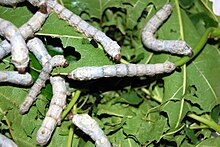Silk worms
| Bombyx mori | |
|---|---|
 |
|
| Paired male (above), female (below) | |
 |
|
| Fifth instar silkworm larvae | |
|
Domesticated
|
|
| Scientific classification | |
| Kingdom: | Animalia |
| Class: | Insecta |
| Order: | Lepidoptera |
| Family: | Bombycidae |
| Genus: | Bombyx |
| Species: | B. mori |
| Binomial name | |
|
Bombyx mori (Linnaeus, 1758) |
|
| Synonyms | |
|
|
| Silkworm (Bombyx mori) | |||||||||||||||||||||||||||||||||||

"Silkworm" in seal script (top), Traditional (middle), and Simplified (bottom) Chinese characters
|
|||||||||||||||||||||||||||||||||||
| Chinese name | |||||||||||||||||||||||||||||||||||
|---|---|---|---|---|---|---|---|---|---|---|---|---|---|---|---|---|---|---|---|---|---|---|---|---|---|---|---|---|---|---|---|---|---|---|---|
| Traditional Chinese | 蠶 | ||||||||||||||||||||||||||||||||||
| Simplified Chinese | 蚕 | ||||||||||||||||||||||||||||||||||
|
|||||||||||||||||||||||||||||||||||
| Japanese name | |||||||||||||||||||||||||||||||||||
| Kanji | 蚕 | ||||||||||||||||||||||||||||||||||
| Kana | カイコ | ||||||||||||||||||||||||||||||||||
|
|||||||||||||||||||||||||||||||||||
| Transcriptions | |
|---|---|
| Standard Mandarin | |
| Hanyu Pinyin | cán |
| Wade–Giles | ts'an2 |
| IPA | [tsʰǎn] |
| Wu | |
| Suzhounese | zœ́ |
| Hakka | |
| Romanization | tsam2 |
| Yue: Cantonese | |
| Yale Romanization | chàahm |
| IPA | [tsʰȁːm] |
| Jyutping | caam4 |
| Southern Min | |
| Tâi-lô | thâm (col.) tshâm (lit.) |
| Old Chinese | |
| Baxter–Sagart (2014) | *C.[dz]ˤ[ə]m |
| Transcriptions | |
|---|---|
| Romanization | kaiko |
The silkworm is the larva or caterpillar of the domestic silkmoth, Bombyx mori (Latin: "silkworm of the mulberry tree"). It is an economically important insect, being a primary producer of silk. A silkworm's preferred food is white mulberry leaves, though they may eat other mulberry species and even osage orange. Domestic silkmoths are closely dependent on humans for reproduction, as a result of millennia of selective breeding. Wild silkmoths are different from their domestic cousins as they have not been selectively bred; they are not as commercially viable in the production of silk.
Sericulture, the practice of breeding silkworms for the production of raw silk, has been under way for at least 5,000 years in China, from where it spread to Korea and Japan, India and later the West. The silkworm was domesticated from the wild silkmoth Bombyx mandarina, which has a range from northern India to northern China, Korea, Japan, and the far eastern regions of Russia. The domesticated silkworm derives from Chinese rather than Japanese or Korean stock.
Silkworms were unlikely to have been domestically bred before the Neolithic age. Before then, the tools to manufacture quantities of silk thread had not been developed. The domesticated B. mori and the wild B. mandarina can still breed and sometimes produce hybrids.
Domestic silkmoths are very different than most members in the genus Bombyx; not only they have lost the ability to fly, but also their color pigments are lost.
Mulberry silkworms can be categorized into three different but connected groups or types. The major groups of silkworms fall under the univoltine ("uni-"=one, "voltine"=brood frequency) and bivoltine categories. The univoltine breed is generally linked with the geographical area within greater Europe. The eggs of this type hibernate during winter due to the cold climate, and cross-fertilize only by spring, generating silk only once annually. The second type is called bivoltine and is normally found in China, Japan, and Korea. The breeding process of this type takes place twice annually, a feat made possible through the slightly warmer climates and the resulting two life cycles. The polyvoltine type of mulberry silkworm can only be found in the tropics. The eggs are laid by female moths and hatch within nine to 12 days, so the resulting type can have up to eight separate life cycles throughout the year.
...
Wikipedia
